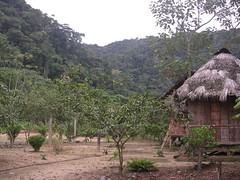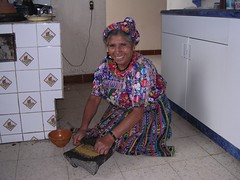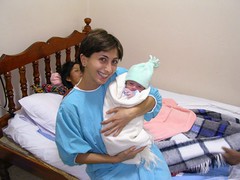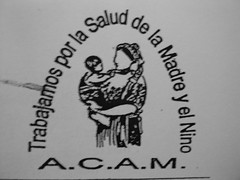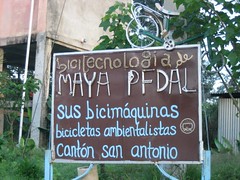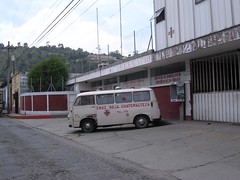Ecotourism, communitarian tourism, ecolodges, ecoresorts are just many names which refer to the same experience: coming in contact with the rain forest and the people (aboriginal peoples) that inhabit it. In the case of the Amazon, because a good part of its future goes necessarily through this type of tourism, we want to give some suggestions, fruit of our experience. Firstly, you should consider that it’s difficult, if not impossible, the integration in the indigenous communities of the forest, there are too many differences. The only way to try a deeper approach to this world it’s to go there as volunteer (voluntourism): in this case better to get information in Quito on the options available, remembering that usually the period of cooperation is at least 3-6 months and that often the volunteers are asked to pay in order to cover expenses and registration fee. If instead you are travelers or tourists, our suggestion is to directly go to one of the cities/entrance gate towards the Amazon (in the case of Ecuador: Tena, Puyo, Macas, Coca or Lago Agrio) and spend there some days, trying to get information or better to know a person able to indicate you the communities that receive visits in the forest. A smart trick is to go to the travel agencies which offer organized tours and ask for their destinations; sure they will deny, but you will always be able to find a passage by bus, canoe or taxi towards the same place. Currently, Kichwa communities in the region of Tena (Napo) offer lodging in wooden cabañas and food for approximately 10 dollars a day. In this case, what you will be able to see is limited to the nearest attractions, unfortunately it’s impossible to explore the forest as independent traveller. Therefore, you’ll have the problem to find a guide who could accompany you in the remote places. After all, especially in the event your group isn’t numerous, it would be better to buy an organized tour by any travel agency, maybe after verifying that your money will be used for the development of the community itself. Last consideration: locals always deny, but tropical diseases exist (dengue, malaria, etc)… avoiding paranoias, take necessary precautions.
For many travelers the ecotourism in the Amazon it’s just a waste of time and money, but with an intelligent approach, it could transform in an opportunity to know and help to preserve one of the most incredible ecosystems of our planet.
Afro Caribbean soul
Afro Caribbean soul, far and neglected spirit, that let seduce itself just beyond the border of the world. In the land of no one, where every man is owner of his life… the land strip that extends from Cartagena towards Playa Blanca and Islas del Rosario, is a dusty fireside of underbrushes and doggone lives, where the whole population it’s of African origin and survives of expedients in the extreme heat. The travelers who cross this border without law get transformed in victims and guilty of a cruel system, money and power. “When you left to us this desert of skeletal cows and foul ponds”. Then, the dancing girls appear from the powder, a frenetic and echoing African rhythm, a cumbia or makulele, a skillful and enchanting dance, mockingly put up in front of a cartel saying: “Don’t give money to the dancing girls who charm the tourists”.
Valhalla, macadamia project
Left the colonial-styled streets of La Antigua, the road heads directly to the impressive Amatenango volcano, under which is placed the village of San Miguel Dueñas. Here, hidden by the green vegetation, we discover the “Estación Experimental Valhalla”, a project of sustainable agriculture dedicated to the production of organic macadamia nuts. The lovely people of the staff explain us that macadamia is a plant coming from Australia, whose properties have been extensively investigated in the last years and whose fruit is currently used in order to produce oils, cosmetics (facial creams), flour and many other products. Various hybrids of the two original species of macadamia grow in the plantation, representing a botanical variety appreciated all over the world (no grafting is performed, thus preserving the genetic purity and diversity). The evergreen plants give fruits all the year round and easily adapt to different climatic conditions, moreover they allow to absorb much more carbon dioxide than many other plants and turn it into water vapor and oxygen. The nuts, once collected, are processed with a handmade sheller (maybe in the future it would be replaced by the bicycle nut-sheller, fruit of the collaboration with Maya Pedal) and left drying for a month, before being washed in order to obtain the end products. While we have an exquisite macadamia breakfast, we feel the enthusiasm demonstrated by the people who work in the plantation. They tell us they accept volunteers for the collection of the nuts and any person who could carry new and productive ideas in this activity. They already count on the enthusiastic support of the rural indigenous communities, which are beginning projects of reforestation, planting macadamia instead of more aggressive cultivations. It’s another successful idea coming from people who love Guatemala and its beautiful land. For further information, visit their website: www.exvalhalla.net.
Guatemalan smiles
An exciting month ends: the volunteering projects, Maya Pedal, the casa ACAM, the smiles of the people who accompanied us along this period… we saw the birth of children and hopes, we seeded friendships and collaborations that we hope will bear good fruits in the future. Our nomadic travel resumes its confused trajectory, some more days still in the splendid land of Guatemala, then many surprises will arrive…
Comadronas para comadronas
The job of “comadrona” (midwife) on the Guatemalan Altiplano, like in many other regions of the world, is a vocation transmitted from mother to daughter. A wisdom handed orally, fruit of experiences lost in the past. The birth of the “casa del parto ACAM” has represented a decisive change in the life of the comadronas of Concepcion Chiquirichapa, concurring to fulfill their dream: to build a pleasant place, clean and supplied with the essential instruments in order to assist the deliveries in complete autonomy. In fact, in the house they do not collaborate with medical staff and the delivery follows the rhythms given by nature. The woman entrusts the acquaintances of the comadrona (traditional midwife) which, beyond practical suggestions, uses curative herbs, known by the Mayan Mam tradition, in order to favor the positive course of the delivery. The moment of the birth is lived with extreme peacefulness: the mother, wearing her typical garment, gives birth in a simple bedroom, encircled by tight relatives and free to express her own feelings in native language, trusting in the full understanding of the comadrona. The birth of the child is celebrated with some propitiatory gestures: the baby, before receiving the breast of the mother, tastes salt and chile (chili pepper) in small amount, as auspice of a life full of taste and satisfactions; moreover he receives in his small hand a money, as wish of prosperity. After approximately one hour from the delivery, the mother enters in a very small room, called Chuj (Temascal) by the Mam tradition, in which the humid warmth is created throwing water on red-hot stones. The comadrona washes the woman with natural soaps and uses special herbs to cure skin abrasions. It is believed that Temascal, beyond possessing a purifying function, has optimal healing properties and favors lactogenesis. Before the family of the baby returns to its own house, the comadronas prepare a meal consisting in soup with vegetables, herbs (rich in iron and vitamins) and Atol (traditional drink made up of maize), taking advantage of the occasion to discuss and joke on the birth of the child.
Living with the comadronas has been an experience of total sharing of the simple and authentic rhythms that you can breath in the casa ACAM: the days, mostly dedicated to kitchen, cleaning and chatter, have been fulfilled by some unforgettable delivery attendances.
Casa ACAM, a story of hope
The icy wind from the north makes shine the stars while we listen to Arturo telling us the story of its incredible life with Teresa, the director of “casa ACAM” (Asociacion Comadronas Area Mam) and their project to improve the condition of the women and the children of Concepcion Chiquirichapa (near Quetzaltenango, Xela)… At the beginning, man was maize that is, in the Mayan cosmovision, a being that constantly had to look for the equilibrium with the other animals, respecting the instruction given by the Mother Earth. The deep acquaintances of the Mayan ancestors in scientific field, pushed them to build up a society based on a progress which we would define sustainable nowadays, in the full respect of the rhythms of nature. It has been the predisposition of this people to share every resource, humbly demanded to the Mother Earth, that took them to the misfortune, when they were forced to follow a radically opposite model by the Europeans. Therefore began for them a sadly famous phase of marginalization and persecution that, in the history of Guatemala, tragically culminated in the thirty years of civil war (1970-1996): a system of abusive powers, the wealth of the great land owners and the unpunishment of the army, carried out the chaos and the violence in the country. Entire Mayan villages were exterminated and the atrocities towards women and children became the rule, while the men (in great majority indigenous farmers or campesinos), were forced from the opposite factions to kill their similar. A few people could back out of this tragic spiral. Arturo, his wife and sons undertook an intense travel towards the north, after resisting as clandestine in their own land for three years. First, they settled in Mexico, where they found an extremely hostile atmosphere and they were enslaved by the large coffee estate owners. Therefore, they reached the United States (1984), a country that in the 80’s was divided between those who sponsored the terror in Guatemala and those who received refugees in sign of protest. Arturo and Teresa had fortune and found a family that received them like siblings, even though in the difficulties and with the constant penance to have abandoned their people in the blood. From this state of mind, upraised the wish to denounce to the world the atrocity of the civil war and at the beginning of the 90’s, they began to travel along the United States informing the public opinion which, day by day, became more and more sensitive towards the indigenous issue and the Latin American situation. They met other Guatemalan refugees and this increased their wish to help their country in concrete terms. In 1998, officially finished the war, Arturo and Teresa could return to their village (Concepcion Chiquirichapa), after an exile lasted nearly twenty years: they found a community in trouble, many of their friends massacred or dispersed. They decided that, to give a future to their people, they had firstly to build a hope for those women and their children. Indeed originated the idea of the “casa ACAM”, a center of support to the family in which the ready and willing “comadronas” (mid-wives) of the Mayan Mam region could gather and have a space dedicated for the delivery attention. As a result of an intense aid demand activity, Arturo found an enthusiastic answer in that part of North American people who saved him years before: collected the money, began the phase of construction of the center, that culminated with the inauguration in 2004. Today ACAM association, a well-known Guatemalan NGO (non-governmental organization), is a reality that has opened the road towards the future for the Mam community and it’s already an example to follow, although a lot remains to build. The enthusiasm of Arturo and Teresa does not leave doubts that they will carry until the end their fight for a better Guatemala, proud of its past and bound to the Mayan tradition.
Maya Pedal, developing bicimaquinas
Maya Pedal is an NGO been born in 1997, with the aim to help the development of the rural communities in Guatemala, through the utilization of the “bicimaquinas”. With the term bicimaquina (bicycle machine) they refer to an intermediate technology, developed from recycled bicycles: therefore it’s a self-sufficient and eco-sustainable technology, as it does not demand electric power or fuel for its operation; moreover it’s a reliable instrument of support for the familiar economy, as the machines produced have always an immediate functionality. In the workshop of San Andres Itzapa (Chimaltenango, Guatemala), thanks also to the contribution of a group of researchers of the MIT (Massachusetts Institute of Technology) of Boston, various types of bicimaquinas are designed and assembled, just as an example: bicycle blenders (bicilicuadoras), bicycle soil mills (bicimolinos), bicycle corn degrainer and coffee depulper (bicidesgranadora de maiz e bicidespulpadora de cafe), water pumps (bicibombas de lazo), washing machines (bicilavadoras), tricycles and bicitaxis, bicycle plows (biciarados) and bicycle electricity generator (bicigenerador de electricidad). Collaborating directly with the fantastic people who create the small staff of the organization, I have been able to understand how much is appreciated in Guatemala and above all in the rural communities the activity of Maya Pedal: every day new interested people and associations come to visit the workshop or contact them, in order to buy and distribute the assembled machines on the territory. It’s so interesting to participate to the simple but brilliant production process of every bicimaquina, which is exclusively based on the utilization of parts of used bicycles, opportunely modified. This article aims to be a suggestion for all who want to get involved in a volunteering project that in concrete terms acts on the territory, carrying benefit to the Guatemalan rural communities, where still lack basic services. The web sites of Maya Pedal and Pedal Power provide a good source of information for anyone interested in the project.
Volunteering in Guatemala
In the last days we have begun a new and stimulating phase of our travel: after many days of intense searches and some disappointment, we have finally found two volunteering projects. We realize indeed the dream to share in a very intense way part of our journey with the Latin American people. Both the activities approach our interests and professions. The nomadic travel takes a pause in geographic sense, but our willing to explore and to know this complex and coloured world does not diminish, maybe enters in a still more conscious phase. In these days, under the deep contradictions of Guatemala, we often discuss on the indigenous issue, the traditions and the discriminations, the real opportunity to help these people. In Guatemala good part of the social support comes guaranteed through a net of associations, NGO and volunteers, but we discover that in this world there are many false promises. Quetzaltenango (Xela) offers a wide range of volunteering projects in the field of renewable energy: Xelateco is a young manufacturing enterprise, concerned with the fabrication of low cost environmentally sound infrastructure improvements (biodigesters, windmills, water pumps and filters, solar water heaters, micro-hydroelectric)… bienvenidos a Guatemala, the country of the “eternal spring”.
Guatemala, enfrentando su futuro
In Guatemala the social inequality catches up unthinkable levels, pushing us to a deep reflection on the situation of the Central American country. In our travel through the regions of Huehuetenango, Alta Verapaz and Quiché, in the north-western and remotest zone of the country, we noticed the situation of abandonment and indigenous social marginalization that the communities living on the mountains suffer. The scarcely productive land and the economy of subsistence continuously threaten those villages, reason for which the familiar nuclei lead a semi-nomadic life or are forced to migrate towards the coast, Chiapas or United States, when they have choice.
The community of Santa Barbara (Huehuetenango) represents a dramatic example: widely unproductive agriculture (95% of the territory is argillaceous), chronic absence of basic services (health, education), water and food refueling distant hours by walking. The situation is so difficult that it becomes evident the lack of the communitarian spirit which always characterizes the indigenous nuclei and that we have found in every village of Chiapas. Guatemala is remembering the first ten years of peace after a bloody civil war and often it is punished by natural catastrophes (lastly, the hurricane Stan), but this cannot be an excuse to perpetuate the discrimination against indigenous people. It’s sad to notice how much attention still enjoy ghosts of the past such us the former president Rios Montt, implied in the extermination of entire Mayan villages at the time of the civil war.
The shadow that follows a child
We have not yet completely understood the actual condition of the native people, or “American Indian” as we usually call them. In the region we are traveling, the tribes of the Navajo (The delight song of tsoai-talee, N. Momaday), Apache, Ute and many other small groups were leading a nomadic life. Crossing their territories, we understand from where comes their deep respect for nature and all beings: those are semi-desertic lands with a continuous scarcity of resources and full of risks, where only the strongest horses (the splendid Mustangs) can survive. We understand why they were nomadic peoples, continuously moving and why their music is so melancholy and full of echoes from the past. It hurts us to see that they are almost obliged to exchange their amazing culture with small amounts of money, in order to go on. On the contrary, it is fascinating what we are learning in New Mexico, where the ancient pueblos (indianpueblo.org) are helped in the attempt to keep alive their culture and traditions.
We love thinking about us as beings coming from the underworld, the Mother Earth, to begin an endless travel through the South, in peace with nature and ourselves… a nomadic travel which we are following too, someway.
